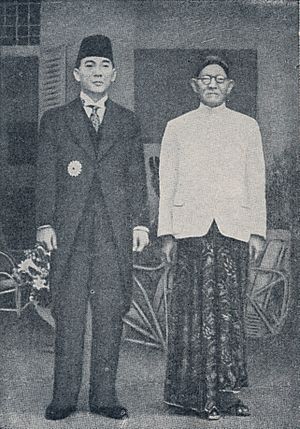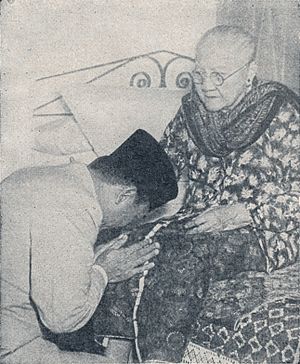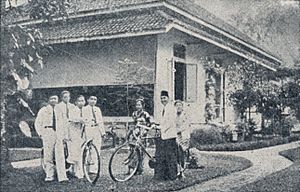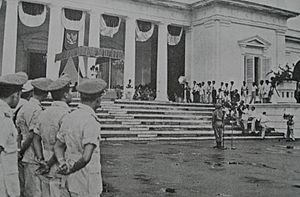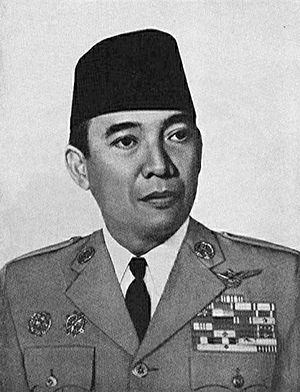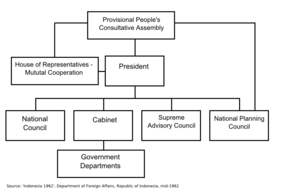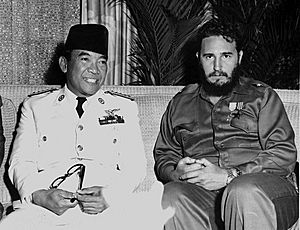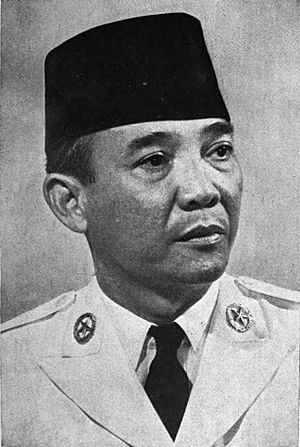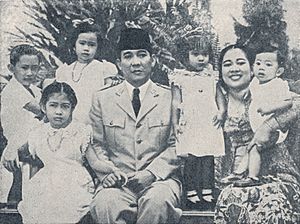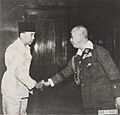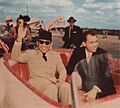Sukarno facts for kids
Quick facts for kids
Sukarno
|
|
|---|---|
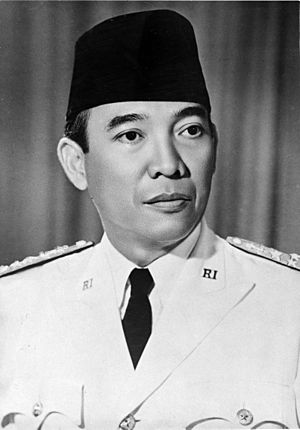
Official portrait, 1949
|
|
| 1st President of Indonesia | |
| In office 18 August 1945 – 12 March 1967 |
|
| Prime Minister |
See list
Sutan Sjahrir
Amir Sjarifuddin Mohammad Hatta Abdul Halim Muhammad Natsir Soekiman Wirjosandjojo Wilopo Ali Sastroamidjojo Burhanuddin Harahap Djuanda Kartawidjaja |
| Vice President | Mohammad Hatta (1945–1956) |
| Preceded by | Position established |
| Succeeded by | Suharto |
| President of the United States of Indonesia | |
| In office 17 December 1949 – 17 August 1950 |
|
| Vice President | Mohammad Hatta |
| Preceded by | Position established |
| Succeeded by | Position abolished |
| Personal details | |
| Born |
Koesno Sosrodihardjo
6 June 1901 Soerabaja, Dutch East Indies |
| Died | 21 June 1970 (aged 69) Jakarta, Indonesia |
| Resting place | Bung Karno's Grave Blitar, East Java, Indonesia 8°05′05″S 112°10′34″E / 8.084622°S 112.176075°E |
| Political party | Indonesian National Party (1927–1931; 1945) |
| Height | 1.70 m (5 ft 7 in) |
| Spouses |
Siti Oetari
(m. 1921; div. 1923)Inggit Garnasih
(m. 1923; div. 1942)Fatmawati
(m. 1943)Hartini
(m. 1953)Kartini Manoppo
(m. 1959; div. 1968)Naoko Nemoto
(m. 1962)Haryati
(m. 1963; div. 1966)Yurike Sanger
(m. 1964; div. 1967)Heldy Djafar
(m. 1966; sep. 1967) |
| Children | 12, including Megawati, Rachmawati, Sukmawati and Guruh |
| Parents |
|
| Alma mater | Bandung Institute of Technology |
| Signature | |
| Military service | |
| Allegiance | |
| Years of service | 1945–1967 |
| Rank | |
| Commands | Indonesian National Armed Forces |
| Battles/wars |
|
Sukarno (born Koesno Sosrodihardjo, 6 June 1901 – 21 June 1970) was an important Indonesian leader. He was a revolutionary and nationalist who became the first president of Indonesia. He served from 1945 to 1967.
Sukarno led Indonesia's fight for independence from the Dutch colonialists. He was a key figure in Indonesia's nationalist movement. The Dutch held him prisoner for over ten years. He was freed by Japanese forces during World War II. Sukarno and other nationalists worked with the Japanese. They gained support for the Japanese war effort. In return, the Japanese helped spread nationalist ideas.
After Japan surrendered, Sukarno and Mohammad Hatta declared Indonesia's independence on 17 August 1945. Sukarno became president. He led the fight against Dutch efforts to re-colonize. This involved both diplomacy and military action. The Dutch finally recognized Indonesia's independence in 1949.
After a period of unstable parliamentary democracy, Sukarno created a new system. He called it "Guided Democracy" in 1959. This system helped end the instability and rebellions. In the early 1960s, Sukarno focused on foreign policy. He promoted anti-imperialism and led the Non-Aligned Movement. This caused tension with Western countries and brought Indonesia closer to the Soviet Union.
After events in 1965, General Suharto took control of the country. This led to a military takeover supported by Western countries. Sukarno was replaced by Suharto in 1967. Sukarno remained under house arrest until his death in 1970.
Contents
Who was Sukarno?
His Name and Background
Sukarno's original name was Koesno Sosrodihardjo. He was renamed Sukarno after a childhood illness. This was a common Javanese custom. His father was a Javanese teacher. His mother was Balinese.
The name Sukarno comes from a hero in the Mahabharata Hindu epic, Karna. His father was inspired by Indian heroes. He wanted his son to be brave and a leader. The spelling Soekarno is still used often. This is because he signed his name using the old Dutch spelling.
Indonesians also called him Bung Karno (Brother/Comrade Karno) or Pak Karno ("Mr. Karno"). Like many Javanese people, he had only one name. Sometimes, he was called "Achmed Sukarno" by foreign journalists. This was to make his name sound more familiar to Western and Arab countries.
Early Life and Education
Sukarno was born in Surabaya, Dutch East Indies (now Indonesia) in 1901. He went to a Dutch primary school in Mojokerto. In 1916, he went to a higher secondary school in Surabaya. There, he met Tjokroaminoto, a nationalist leader.
In 1921, Sukarno studied civil engineering at the Bandung Institute of Technology. He earned his engineering degree in 1926. While studying, he became fluent in several languages. Besides Javanese, he mastered Sundanese, Balinese, and Indonesian. He was also very good at Dutch, German, English, French, Arabic, and Japanese.
Sukarno was very modern in his thinking. He disliked traditional Javanese feudalism and Western imperialism. He believed these systems caused poverty in Indonesia. He wanted to promote national pride. He used his ideas in his clothing, city planning for Jakarta, and socialist politics.
Architectural Career
After graduating in 1926, Sukarno started an architectural firm. It was called Sukarno & Anwari in Bandung. He designed many private houses. Later, as president, he continued to be involved in architecture. He designed important monuments like the Proclamation Monument in Jakarta. He also planned the new city of Palangkaraya.
The Fight for Independence
Starting the Nationalist Movement
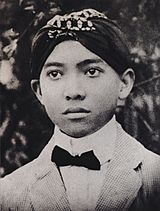
Sukarno first learned about nationalist ideas from Oemar Said Tjokroaminoto. As a student, he studied many political ideas. He developed his own ideology called Marhaenism. This idea focused on Indonesian self-sufficiency.
On 4 July 1927, Sukarno and his friends formed the Indonesian National Party (PNI). Sukarno was its first leader. The party wanted Indonesia to be independent. It opposed imperialism and capitalism. The PNI also supported secularism and unity among Indonesia's many ethnic groups. The party quickly gained many followers.
Arrest and Imprisonment

The Dutch colonial government noticed the PNI's activities. Sukarno and other PNI leaders were arrested on 29 December 1929. During his trial in 1930, Sukarno gave powerful speeches. These speeches attacked colonialism. He called them Indonesia Menggoegat (Indonesia Accuses).
In December 1930, Sukarno was sentenced to four years in prison. He served time in Sukamiskin prison in Bandung. His speeches were widely reported. Due to public pressure, he was released early on 31 December 1931. He became a popular hero across Indonesia.
After his release, Sukarno tried to unite different nationalist groups. He became the head of the Partindo party. In 1933, he was arrested again for his writings. The Dutch sent him into exile without a trial.
Exile in Remote Areas
In 1934, Sukarno was sent to Ende on the island of Flores. He used his time there to start a children's theater. Later, in 1938, he was moved to Bencoolen on Sumatra. In Bengkulu, he taught at a local school. One of his students was 15-year-old Fatmawati, who he later married. Sukarno was still in exile when Japan invaded Indonesia in 1942.
World War II and Japanese Occupation
Working with the Japanese
In 1942, Imperial Japan invaded the Dutch East Indies. The Japanese quickly defeated the Dutch forces. Sukarno saw this as a chance for Indonesia to gain independence. The Japanese wanted Sukarno's help to gain support from Indonesians.
Sukarno agreed to work with the Japanese. In return, he could spread nationalist ideas to the people. The Japanese needed Indonesia's workers and resources for their war. They forced millions of Indonesians to work as "romusha" (forced labor). They also took food from Indonesian farmers.
Sukarno was put in charge of organizations like Poesat Tenaga Rakjat (POETERA). These groups aimed to get public support for the Japanese war effort. Sukarno later felt ashamed of his role in the romusha program. He believed these sacrifices were necessary for Indonesia's future independence. He also helped form Indonesian volunteer army units.
In 1943, Sukarno married Fatmawati. They lived in a house in Jakarta. This house later became the place where Indonesia's independence was declared.
In November 1943, Sukarno visited Japan. He was honored by Emperor Hirohito. In September 1944, Japan promised independence for Indonesia. This showed that Sukarno's cooperation with Japan was seen as important.
Preparing for Independence

In April 1945, Japan allowed the creation of the Investigating Committee for Preparatory Work for Independence (BPUPK). Sukarno led this committee. Its job was to prepare for a future Indonesian state.
On 1 June 1945, Sukarno introduced his five guiding principles. These principles are known as Pancasila. They were meant to unite all Indonesians. The five principles were:
- Nationalism: A united Indonesian state.
- Internationalism: Indonesia should promote human rights and world peace.
- Democracy: Decisions made through discussion and agreement.
- Social justice: Fair sharing of economic benefits for all.
- Belief in God: All religions treated equally with freedom.
On 7 August 1945, a smaller committee was formed. It was called the Preparatory Committee for Indonesian Independence (PPKI). Its task was to create the government structure. On 9 August, Sukarno and other leaders met with a Japanese commander in Vietnam. They were told Indonesia could prepare for independence without Japanese interference.
Japan Surrenders and Independence is Declared
The next day, 15 August, Japan surrendered to the Allies. Sukarno learned this from youth leaders. They urged him to declare independence right away. Sukarno was worried about conflict with the Japanese or future Allied forces.
On 16 August, impatient youth leaders took Sukarno to Rengasdengklok. They convinced him to declare independence the next day. That night, Sukarno and Sajoeti Melik prepared the text for the Proclamation of Indonesian Independence.
Indonesia's Revolution and New Nation
Declaring Independence
On the morning of 17 August 1945, Sukarno and Mohammad Hatta stood on the porch of Sukarno's house. In front of about 500 people, Sukarno declared the independence of the Republic of Indonesia.
The next day, 18 August, the PPKI set up the new government:
- Sukarno and Mohammad Hatta were named president and vice-president.
- The 1945 Indonesian constitution was put into effect.
- A national committee (KNIP) was formed to help the president.
Sukarno's vision for the constitution included the Pancasila (five principles). His political ideas combined parts of Marxism, nationalism, and Islam. He believed all national principles could be summarized as gotong royong (working together).
The Revolution Begins
News of independence spread quickly. On 19 September, Sukarno spoke to a million people in Jakarta. This showed strong support for the new Republic. In Java and Sumatra, Sukarno's government quickly took control.
The new Republic faced challenges. Armed groups attacked Europeans, Chinese, and others seen as opposing independence. These conflicts continued until early 1946.
The government initially delayed forming a national army. They feared angering the Allied forces. In October 1945, the BKR (People's Security Organization) became the TKR (People's Security Army). They got weapons by taking them from Japanese troops.
British forces arrived in Indonesia in late September 1945. They aimed to free Allied prisoners and return Indonesia to Dutch control. Sukarno's government cooperated with releasing prisoners. But Sukarno wanted international recognition for Indonesia. He knew his past cooperation with Japan might make Western countries distrust him.
To gain international trust, Sukarno allowed a parliamentary government. A prime minister would manage daily affairs. Sukarno would remain as a figurehead president. On 14 November 1945, Sutan Sjahrir became the first prime minister. He had not worked with the Japanese.
Fighting broke out between Indonesian forces and Dutch/British troops. In January 1946, Sukarno and his government moved to Yogyakarta for safety. Yogyakarta became the Republic's capital.
By November 1946, British soldiers left Indonesia. They were replaced by over 150,000 Dutch soldiers. After negotiations, the Linggadjati Agreement was signed in November 1946. The Dutch recognized Indonesian control over Java, Sumatra, and Madura.
Continued Conflict and Exile
Sukarno's decision to negotiate faced strong opposition. Some groups wanted complete independence and no negotiations. In July 1947, the Dutch broke the agreement. They launched a large military invasion called Operatie Product. This angered the world. International pressure forced the Dutch to stop.
The United Nations called for a ceasefire. A committee was formed to oversee it. Indonesia was now under Dutch military control. The Dutch occupied many key areas. In January 1948, the Renville Agreement was signed. This agreement gave the Dutch control over the areas they had taken.
Political instability continued. In September 1948, a communist rebellion broke out in Madiun, East Java. The government defeated the rebels by October 1948.
On 19 December 1948, the Dutch launched another invasion, Operatie Kraai. They attacked Yogyakarta. Sukarno ordered his army to fight as guerrillas. He and other leaders allowed themselves to be captured. Sukarno was sent to Bangka.
The second Dutch invasion caused more international outrage. The United States threatened to cut aid to the Netherlands. Indonesian forces continued to fight. The Dutch were forced to sign the Roem–Van Roijen Agreement in May 1949. This led to the complete transfer of sovereignty to Indonesia on 27 December 1949. Sukarno returned to Jakarta, making a triumphant speech.
Leading the New Nation
President of the United States of Indonesia
Indonesia became a federal state called the Republic of United States of Indonesia (RIS). This was a compromise with the Dutch. By August 1950, all the smaller states joined together. Sukarno then declared a united Republic of Indonesia.
Challenges of Early Democracy (1950–1959)
The first years of Indonesia's parliamentary democracy were unstable. Governments changed quickly due to disagreements between political parties. There were debates about whether Indonesia should be a secular, Islamic, or communist state.
Rebellions broke out in different regions. Some groups, like the Darul Islam rebels, wanted an Islamic state. There were also conflicts within the military.
In 1955, new elections were held. No single party won a clear majority. This meant political instability continued. Sukarno became unhappy with the Western-style democracy. He felt it was not right for Indonesia.
He proposed "guided democracy," based on traditional Indonesian village decision-making. He believed the president should guide the nation like a village elder. Vice President Mohammad Hatta disagreed and resigned in 1956.
Martial Law and Stronger Leadership
From late 1956 to early 1957, regional military commanders took control in some provinces. They refused orders from Jakarta. They wanted less communist influence and fair sharing of government money.
In response, Sukarno declared martial law in March 1957. He appointed a new prime minister and relied on General Abdul Haris Nasution. Nasution agreed with Sukarno that Western democracy was not working for Indonesia.
In November 1957, there was an assassination attempt on Sukarno. Members of the Darul Islam group were responsible. Sukarno was not seriously hurt.
In December 1957, Sukarno took strong action. He nationalized 246 Dutch companies in Indonesia. He also expelled 40,000 Dutch citizens. This was because the Dutch refused to negotiate on Netherlands New Guinea.
In February 1958, some rebel commanders declared the PRRI-Permesta Movement. They aimed to overthrow the government. The United States' CIA secretly supported them. But the rebels were defeated by the end of 1958.
Guided Democracy (1959–1966)
Sukarno's military victories and nationalization of Dutch companies made him very powerful. On 5 July 1959, Sukarno brought back the 1945 constitution. This created a presidential system. He called his system Manifesto Politik or Manipol. It was a government led by his decrees.
Sukarno wanted an Indonesian-style socialist society. It was based on USDEK:
- Undang-Undang Dasar '45 (Constitution of 1945)
- Sosialisme Indonesia (Indonesian socialism)
- Demokrasi Terpimpin (Guided Democracy)
- Ekonomi Terpimpin (Commanded Economy)
- Kepribadian Indonesia (Indonesia's Identity)
Sukarno disbanded parliament and created a new one. Half its members were appointed by him. He also established a Provisional People's Consultative Assembly (MPRS). This was the highest legislative body.
He banned some political parties. The military arrested many of his political opponents. Newspapers critical of his policies were closed. There were also more assassination attempts on Sukarno. In 1960, a pilot tried to bomb the palace. In 1962, Darul Islam agents shot at him. Sukarno was unharmed.
To balance the military's power, Sukarno relied on the Communist Party of Indonesia (PKI). In 1960, he declared his government was based on Nasakom. This was a mix of nationalism, religions, and communism. He allowed more communists into his government.
Sukarno also worked to increase Indonesia's global standing. He hosted the 1962 Asian Games in Jakarta. He built large sports facilities, like the Bung Karno Stadium. When Indonesia was sanctioned for not allowing Israeli and Taiwanese delegations, Sukarno created his own event. It was called the Games of New Emerging Forces (GANEFO).
He also ordered the building of grand monuments and modern infrastructure. This included the National Monument and Hotel Indonesia. He wanted to transform Jakarta into a modern city.
Foreign Policy and Global Influence
Building Alliances
On the international stage, Sukarno organized the Bandung Conference in 1955. The goal was to unite developing Asian and African countries. This led to the Non-Aligned Movement. It aimed to be independent from both the United States and the Soviet Union.
Sukarno strengthened ties with China and the Soviet Union. The Soviet Union gave Indonesia a lot of military aid. This made the US worried about Indonesia becoming communist.
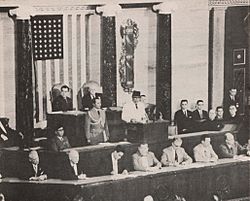
Sukarno visited the United States in 1956. He spoke to the U.S. Congress. He also visited the Soviet Union and received a warm welcome. Soviet Premier Nikita Khrushchev visited Indonesia in 1960.
Sukarno tried to create a new alliance called the "New Emerging Forces" (NEFO). This was against the "Old Established Forces" (OLDEFO) which he saw as imperialist. In 1961, he helped establish the Non-Aligned Movement (NAM). He worked with leaders like Egypt's Gamal Abdel Nasser and India's Jawaharlal Nehru. NAM aimed to give political power to newly independent nations.
West Irian and Malaysia
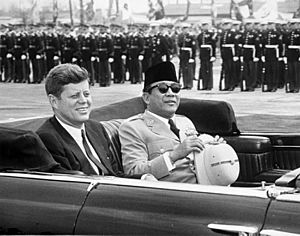
In 1960, Sukarno began an aggressive foreign policy to claim Indonesian territories. He broke ties with the Netherlands over Netherlands New Guinea (West Irian). In 1961, he declared a military confrontation. Indonesian soldiers were sent into West Irian.
The United States worried Indonesia would turn communist. In 1962, the New York Agreement was signed. The Netherlands agreed to hand over West Irian to the United Nations. It was then transferred to Indonesia in May 1963.
After gaining West Irian, Sukarno opposed the formation of Malaysia in 1963. He called it a "neo-colonial plot." This led to the Indonesia–Malaysia confrontation (Konfrontasi). Indonesian soldiers and guerrillas were sent into North Borneo and the Malay Peninsula. Indonesian agents also set off bombs in Singapore. British companies in Indonesia were nationalized. The confrontation ended in early 1966.
In 1964, Sukarno started an anti-American campaign. American businesses were attacked. American movies and books were banned. U.S. aid to Indonesia was stopped. Sukarno famously said, "Go to hell with your aid". In January 1965, Indonesia left the United Nations.
Sukarno then formed an alliance with China, North Korea, North Vietnam, and Cambodia. He called it the "Beijing-Pyongyang-Hanoi-Phnom Penh-Jakarta Axis." He wanted to create a rival to the UN called the Conference of New Emerging Forces (CONEFO).
Domestic Challenges and Economic Decline
Sukarno focused on politics, but Indonesia's economy suffered. The government printed too much money. This caused very high inflation (over 600% in 1964–1965). Smuggling and poor exports meant less foreign money. Most of the budget went to the military. Roads, railways, and other public services got worse. Food shortages happened in many places.
Sukarno did not focus on economics. He believed in Indonesia "standing on its own feet" (Berdikari). He wanted economic self-sufficiency, free from foreign influence. But the economic problems made people unhappy.
Rise of the PKI
Sukarno's "guided democracy" relied on the military and the communists. But these two groups had conflicts. The military, nationalists, and Islamic groups worried about the fast growth of the communist party (PKI). They feared Indonesia would become a communist state. By 1965, the PKI had three million members.
Sukarno showed more support for the communists. The PKI always supported his policies. Sukarno saw the PKI as well-organized. He also used them to get more aid from communist countries.
Tensions between the military and communists grew. In April 1965, the PKI leader called for an "armed force" of peasants and workers. Sukarno approved this idea. But the Army Chief and Defense Minister delayed it. They did not want the PKI to have its own army.
In August 1965, Sukarno warned the Army not to interfere. He also supported the idea of an armed "fifth force."
Removal from Power and Death
The 30 September Movement
On 1 October 1965, six top army generals were kidnapped and murdered. This was done by a group called the "30 September Movement" (G30S). They claimed they were protecting Sukarno from a CIA-backed coup.
Major General Suharto took control of the army the next morning. He ordered troops to take over key locations. The coup quickly failed. Sukarno moved to Bogor Palace.
On 3 October, the bodies of the murdered generals were found. Suharto led their public burial. The military then started a propaganda campaign. They convinced people that it was a Communist coup. PKI members were arrested and many were killed. Estimates say at least half a million people died.
The PKI, one of Sukarno's main supporters, was destroyed. Sukarno tried to protect the PKI. But his power was collapsing.
Transition to New Order
On 1 October 1965, Sukarno appointed a new Army Chief. But he was forced to give the position to Suharto two weeks later. In February 1966, Sukarno reshuffled his cabinet. He removed General Nasution as Defense Minister.
Students began protesting against Sukarno. They demanded the PKI be banned and inflation be controlled. In February 1966, a student was killed by Presidential Guards. He became a martyr for the student movement.
Supersemar
On 11 March 1966, Sukarno signed a Presidential Order known as Supersemar. He gave Suharto the authority to "take all measures necessary to guarantee security, calm and stability." This order effectively transferred power to Suharto.
After getting the order, Suharto declared the PKI illegal. He arrested many officials loyal to Sukarno. This greatly reduced Sukarno's political power.
House Arrest and Death
On 22 June 1966, Sukarno gave a speech to the MPRS (People's Consultative Assembly). He tried to defend himself and his guided democracy. But it was unsuccessful. In August 1966, Indonesia ended its conflict with Malaysia and rejoined the United Nations.
On 12 March 1967, Sukarno was stripped of his president-for-life title. The MPRS named Suharto acting president. Sukarno was put under house arrest. His health got worse. He died of kidney failure on 21 June 1970, at age 69. He was buried in Blitar, East Java.
Sukarno's Family Life
Marriages and Children
Sukarno married several times. His wives included Siti Oetari, Inggit Garnasih, and Fatmawati. He later married Hartini, and then Naoko Nemoto (renamed Dewi Sukarno).
He had 12 children. His daughter, Megawati Sukarnoputri, later became the fifth president of Indonesia. His son, Guruh Sukarnoputra, is a choreographer and songwriter. Other children, Guntur, Rachmawati Sukarnoputri, and Sukmawati Sukarnoputri, have also been active in politics.
Honors and Recognition
Sukarno received many honorary doctorate degrees. These came from universities around the world. He was often called 'Dr. Ir. Sukarno', combining his doctorate with his engineering degree.
He also received many national and foreign honors for his service.
Images for kids
See also
 In Spanish: Sukarno para niños
In Spanish: Sukarno para niños
- Asian-African Conference
- History of Indonesia
- Withdrawal of Indonesia from UN
- Cold War in Asia#Indonesia


